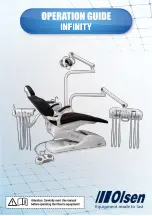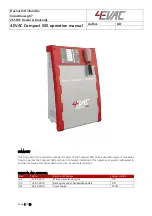
is present, the battery is biased out of the circuit with the diode and is merely being trickle charged though a
resistor.
The battery charges only when the unit is powered on.
The motor driver circuit turns the DC motor coils in the incubator airflow fan motor on and off based on
feedback from the hall effect position sensors. This integrated circuit can also vary the speed and brake the
motor based on input signals from the Control Board.
The airflow sensor consists of an opto-coupler that outputs a clocking pulse proportional to the fan movement.
The signal is AC coupled to eliminate offset voltages and drifts. The resulting pulse is half wave rectified and
stored in a capacitor to yield a DC voltage proportional to the fan speed. If the fan stops or there is no fan, this
DC voltage becomes zero. The output signal is provide to the Control Board to indicate proper airflow motor
operation.
The canopy and elevating base motor control circuits consist of a series of three relays. The speed relay
connects the 15 volt secondaries of the toroidal transformer in parallel (with 15 volt output) for lowering the
canopy and in series (with 30 volt output) for raising the canopy and raising or lowering the elevating base. The
direction relay reverses the polarity of the voltage output from the speed relay depending on the direction of
travel. The E/H select relay switches the output voltage from the direction relay to the canopy or elevating base
motor depending on the switch that is pressed.
To minimize arcing in the relay contacts, the EH Activate MOSFET is switched off while the relays are switched
for the proper voltage, direction, and motor. Once the relays are set, the MOSFET is switched on and proper
voltage is applied to the correct motor.
The motor current sense circuit consists of a small signal transformer that produces a current proportional to
the motor current. The transformer output current is converted to a voltage and filtered. An output voltage
indicative of the motor current amplitude is provided to the Control Board. A subsequent comparator then
generates a digital level based on a specified current level. This results in a signal to the Control Board
indicating whether or not the e-base motor is stalled.
The Relay Board interfaces the user and system status input switch signals to the Control Board. Switch signals
include, e-base and canopy activation, canopy and heater door position, and humidifier reservoir and water
level status.
1.3 Display Driver Board / EL Display
The Display Driver board contains the same Intel microcontroller as the Control board. The processor on the
display board is used to control the EL display contents and monitor user inputs received from the membrane
switch panel and rotary encoder knob.
There are two groups of digital inputs: membrane switch panel and rotary encoder knob. The membrane
switches are pulled high; pressing the switch grounds the input. The encoder also has a switch, and two
optically isolated lines that pulse out of phase with each other. The number of pulses represents the number of
steps the knob rotates. The phase of the pulses represents the direction of the knob rotation.
The display board system memory consists of a programmable read-only memory (PROM) and static random
access memory (SRAM).
4
6600-0343-000 104
© 2001 by Datex-Ohmeda, Inc.. All rights reserved.
Chapter 1: Functional Description
Содержание Giraffe OmniBed
Страница 10: ...x 6600 0343 000 104 2001 by Datex Ohmeda Inc All rights reserved Table of Contents ...
Страница 28: ...xxviii 6600 0343 000 104 2001 by Datex Ohmeda Inc All rights reserved About this Manual ...
Страница 38: ...10 6600 0343 000 104 2001 by Datex Ohmeda Inc All rights reserved Chapter 1 Functional Description ...
Страница 48: ...20 6600 0343 000 104 2001 by Datex Ohmeda Inc All rights reserved Chapter 2 Service Checkout ...
Страница 56: ...28 6600 0343 000 104 2001 by Datex Ohmeda Inc All rights reserved Chapter 3 Calibration and Maintenance ...
Страница 260: ...232 6600 0343 000 104 2001 by Datex Ohmeda Inc All rights reserved Chapter 6 Illustrated Parts ...
















































